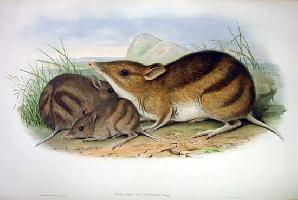
Váhy a míry
| Délka | od 27 do 35 cm |
|---|---|
| Hmotnost | od 450 do 900 g |
Stav ohrožení
| Ohrožen |
Popis zvířete
The Eastern barred bandicoot (Perameles gunnii) is a small, nocturnal marsupial native to Tasmania and formerly found in parts of Victoria, Australia. This fascinating creature has a distinctive appearance and life cycle, which, coupled with its ecological significance and conservation status, makes it an interesting subject of study.Physical Characteristics:
The Eastern barred bandicoot is relatively small, typically weighing between 300 to 700 grams and measuring around 30 to 40 cm in length, with a tail that spans approximately half the length of its body. One of its most distinctive features is the series of dark bars that run across its hindquarters, which gives the species its name. The animal's coat is generally a mix of brown and grey, helping it blend into the underbrush and grasslands that comprise its natural habitat. Its snout is pointed, and it has large, rounded ears, which enhance its auditory senses for navigating the nocturnal landscape.
Habitat and Distribution:
Historically, Eastern barred bandicoots were found in various habitats across Tasmania and Victoria, including grasslands, open woodlands, and the edges of dense forests. However, their range has significantly diminished due to habitat destruction, predation by introduced species like foxes and cats, and competition from rabbits for food. In Victoria, they are now mostly limited to small, managed reserves and conservation areas.
Diet and Behavior:
Eastern barred bandicoots are omnivorous, with a diet that primarily consists of insects, worms, small invertebrates, and plant material. They are solitary animals, coming together only to mate. Their nocturnal habits help them avoid predators and the heat of the day. Using their strong forelimbs and pointed snout, they forage by digging small conical holes in the ground to sniff out their prey. This foraging behavior, while beneficial for their diet, also plays a crucial role in soil aeration and the dispersal of fungal spores, highlighting their importance in ecosystem functioning.
Reproduction and Lifecycle:
The reproductive cycle of the Eastern barred bandicoot is quite remarkable for its rapidity. Females can give birth to up to four litters a year, with each litter consisting of up to four young. The gestation period is incredibly short, lasting only about 12 days, one of the shortest among mammals. After birth, the young bandicoots, called joeys, continue to develop in the mother's pouch for around two months before becoming more independent. This rapid reproductive rate is essential for the survival of the species, especially given the numerous threats they face.
Conservation Status:
The Eastern barred bandicoot is listed as an endangered species, with the main threats to its survival being habitat loss, predation by non-native species, and vehicular accidents. Conservation efforts are underway to protect and restore its habitat, including breeding programs and the establishment of predator-free areas. Public awareness and community involvement in conservation efforts are also critical to the survival of this unique marsupial.
In conclusion, the Eastern barred bandicoot is a small but remarkable marsupial with distinctive physical characteristics, an interesting diet and behavior, and a rapid reproductive cycle. Despite facing significant threats to its survival, ongoing conservation efforts offer hope for the future of this unique species.
Nové fotografie zvířat
Top 10 zvířat
- Chinese water dragon (Physignathus cocincinus)
- Galápagos tortoise (Geochelone nigra complex)
- Dolphin gull (Leucophaeus scoresbii)
- Japanese macaque (Macaca fuscata)
- Colombian red howler (Alouatta seniculus)
- Sea urchins (Echinoidea)
- Moustached guenon (Cercopithecus cephus)
- Diana monkey (Cercopithecus diana)
- Common reed warbler (Acrocephalus scirpaceus)
- Common house mosquito (Culex pipiens)